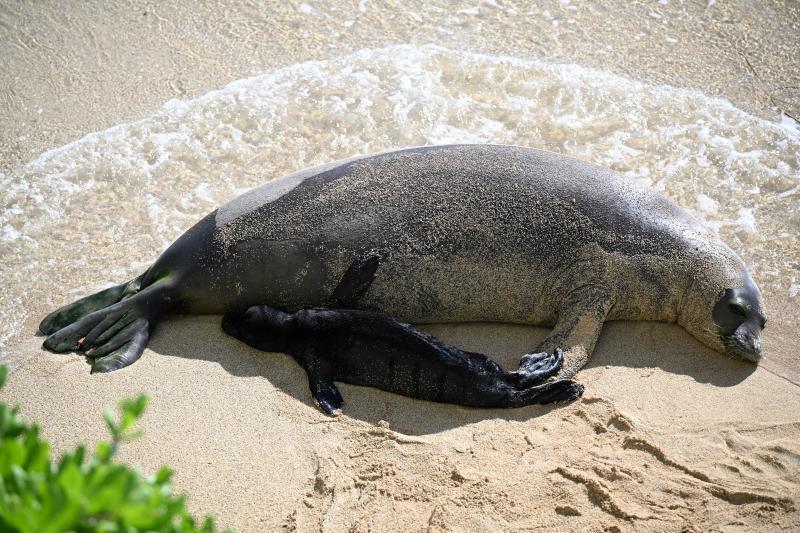
Monk Seal pup debuts in Waikiki on Lei Day
by NOAA Fisheries 11 May 2024 17:25 UTC

Hawaiian monk seal RK96 (Kaiwi) and her newborn pup at Kaimana Beach, Waikiki © NOAA Fisheries (Permit #24359)
Endangered Hawaiian monk seal RK96 (Kaiwi) gave birth to her sixth pup on popular Kaimana Beach in Waikiki, Oahu! The birth was reported on May 1, 2024.
Maybe you've heard the song "May Day is Lei Day in Hawaii" by Leonard "Red" and Ruth Hawk?
May 1 is a special day in the islands as people celebrate the traditions and culture of Hawaii through the giving and receiving of lei. This year, Lei Day was marked by another special gift—the arrival of an endangered Hawaiian monk seal pup!
Mother seal RK96, commonly known as Kaiwi, gave birth to her latest pup on Kaimana Beach in Waikiki! Community members reported the birth on May 1, 2024, and NOAA Fisheries, state, county, and non-profit partners put our joint response plan in action.
Hawaiian monk seals are one of the most endangered seal species in the world, so each pup represents hope for the species' recovery. Unfortunately, new pups are also very vulnerable. It takes a combined effort to help them survive!
Taking Care of Baby
During the 5- to 7-week nursing period, Kaiwi and her pup will be inseparable. The pup will spend most of its time nursing. It needs mom's milk to develop properly and build reserves for surviving on its own when Kaiwi leaves in a few short weeks. If Kaiwi is disturbed during this critical period, she could abandon her pup, and the pup's survival could be in jeopardy.
NOAA Fisheries, the Department of Land and Natural Resources, the City and County of Honolulu, and Hawaii Marine Animal Response are collaborating to ensure that does not happen.
Learn more about our protection efforts.
"Giving these seals space is really the number one way you can support Hawaiian monk seal mothers and their pups," said Kilali Gibson, Oahu Marine Wildlife Response Coordinator, NOAA Fisheries Pacific Islands Regional Office. "Approaching or attempting to play or swim with monk seals can change their behavior and ability to survive on their own in the wild."
Keeping your distance is also important for your personal safety. Hawaiian monk seals are generally not aggressive—but that can change during motherhood. Mother seals can be very protective of their new pups and have seriously injured swimmers in the past. We and partners strongly recommend using alternate areas for beach and ocean recreation, such as swimming.
"By staying behind the perimeter and choosing to swim at a different beach, you can stay safe while also playing a big part in helping recover this endangered species," Gibson added.
More About Kaiwi
This is now Kaiwi's sixth pup! She was born on Oahu on the Kaiwi coastline and is 13 years old.
Her previous pups include:
- 2023 - RS36 (Pualani), female born on Kaimana Beach, Waikiki
- 2021 - RP96 (Lolii), male born on Kaimana Beach, Waikiki
- 2020 - RM26 (Nohea), female born along Kaiwi coastline
- 2018 - RK24 (Wawamalu), male born along Kaiwi coastline
- 2016 - RH36 (Kawena), female born along Kaiwi coastline
Kaiwi is the second known seal to give birth in Waikiki. The first was RH58 (Rocky). In 2017, Rocky gave birth to RJ58 (Kaimana) in 2017 and RQ58 (Koalani) in 2022.
Ways You Can Help
There are only about 1,600 Hawaiian monk seals left. They are native to Hawai?i and live nowhere else in the world. Federally, they are protected under the Endangered Species Act and the Marine Mammal Protection Act.
If you encounter a Hawaiian monk seal, prepare to fall in love (we have!). And remember to follow these guidelines:
- Keep a distance of at least 50 feet (150 feet for mothers with pups)
- Stay behind any signage and listen to on-site personnel
- Keep dogs on a leash
- Report all sightings of Hawaiian monk seals to the NOAA Fisheries Marine Wildlife Hotline at (888) 256-9840
Interested in following along on the pair's time together? Stay tuned to our
Hawaiian Monk Seal Updates page and social media for future updates!